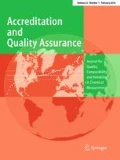Abstract
A proficiency test (PT) was organized for quality control analysis of black tea. Test materials for the analyses of total content of powder tea, moisture, total ash, acid-insoluble ash, water-soluble ash, alkalinity of water-soluble ash, water extract, crude fiber and caffeine were sent to the participant laboratories (n:43) in 2009. The assigned value, standard deviation of the parameters and z-scores of the participant laboratories were calculated using the data reported by the participants. The percentage of the reported results for analytes was found to be ranged from 67.5 to 100%. Acceptable z-scores were achieved by 80.5–97.5% of the participant laboratories. More than 15% of unacceptable results were obtained for acid-insoluble ash and caffeine analyses. The quality control material for quality control analysis of black tea was developed from the remaining material.


References
ISO/IEC 17043 (2010) Conformity assessment-general requirements for proficiency testing
Poulsen ME, Christensen HB, Herrman SS (2009) Proficiency test on incurred and spiked pesticide residues in cereals. Accredit Qual Assur 14:477–485
McEwan JA, Hunter EA, van Gemert LJ, Lea P (2002) Proficiency testing for sensory profile performance. Food Qual Prefer 13:181–190
ISO/IEC 17025 (2005) General requirements for the competence of test and calibration laboratories
Gaunt W, Whetton M (2009) Regular participation in proficiency testing provides long term improvements in laboratory performance: an assessment of data over time. Accredit Qual Assur 14:449–454
Raposo F, de la Rubia MA, Borja R, Alaiz M, Beltran J, Cavinato C, Clinckspoor M, Demirer G, Diamadopoulos E, Helmreich B, Jenicek P, Marti N, Mendez R, Noguerol J, Pereira F, Picard S, Torrijos M (2009) An interlaboratory study as useful tool for proficiency testing of chemical oxygen demand measurements using solid substrates and liquid samples with high suspended solid content. Talanta 80:329–337
Miller WG (2009) The role of proficiency testing in achieving standardization and harmonization between laboratories. Clin Biochem 42:232–235
Earnshaw A, Smith RA, Owen L (2009) How proficiency testing can improve the quality of analytical data using vitamin analysis as an example. Food Chem 113:781–783
ISO Guide 35 (2006) Reference materials-general and statistical principles for certification
Castanheira C, Abrantes C, Batista M, Coelho I, Sanchez-Silva A (2009) Quality control materials in food composition on databanks. Food Chem 113:768–775
Emons H, Held A, Ulbert FM (2006) Reference material as crucial tool for quality assurance and control in food analysis. Pure Appl Chem 78:135–143
Anonymous (2002) Food analysis performance assessment scheme (FAPAS) protocol for the organisation and analysis of the data, 6th edn. Central science laboratory. York, UK
Food and Agricultural Organizations of the United Nations (FAO) (2010) FAOSTAT Database http://www.fao.org
Dufrense CJ, Farnworth ER (2000) Tea, Kombucha, and health : review. Food Res Int 33:409–421
Khan N, Mukhtar H (2007) Tea polyphenols for health promotion. Life Sci 81:519–533
ISO 3720 (2011) Black tea-Definition and basic requirements. International Organization for Standardization
Yao L, Liu X, Jiang Y, Caffin N, D’Arcy B, Singanusong R, Datta N, Xu Y (2006) Compositional analysis of teas from Australian supermarkets. Food Chem 94:115–122
EPTIS the worldwide proficiency testing information systems. Available from www.eptis.bam.de
Thompson M, Wood R (1993) The international harmonised protocol for the proficiency testing of (chemical) analytical laboratories. Pure Appl Chem 65(9):2123–2144
Thompson M, Wood R (1993) The international harmonised protocol for the proficiency testing of (chemical) analytical laboratories. J AOAC Int 76(4):926–940
Chakravarti IM, Laha RG, Roy J (1967) Handbook of methods of applied statistics, vol 1. Wiley, London, pp 392–394
Analytical Methods Committee (1989) Robust statistics—how not to reject outliers. Part 1. Basic concepts. Analyst 114:1693–1697
ISO 13528 (2005). Statistical methods for use in proficiency testing by interlaboratory comparisons
Acknowledgment
The authors would like to express thanks Trabzon Provincial Laboratory for the technical support.
Author information
Authors and Affiliations
Corresponding author
Rights and permissions
About this article
Cite this article
Baltacı, C., İlyasoğlu, H., Sarıkaya, S.B.Ö. et al. A proficiency test scheme for the quality control of black tea and development of quality control material for internal quality control. Accred Qual Assur 16, 507–513 (2011). https://doi.org/10.1007/s00769-011-0799-5
Received:
Accepted:
Published:
Issue Date:
DOI: https://doi.org/10.1007/s00769-011-0799-5

